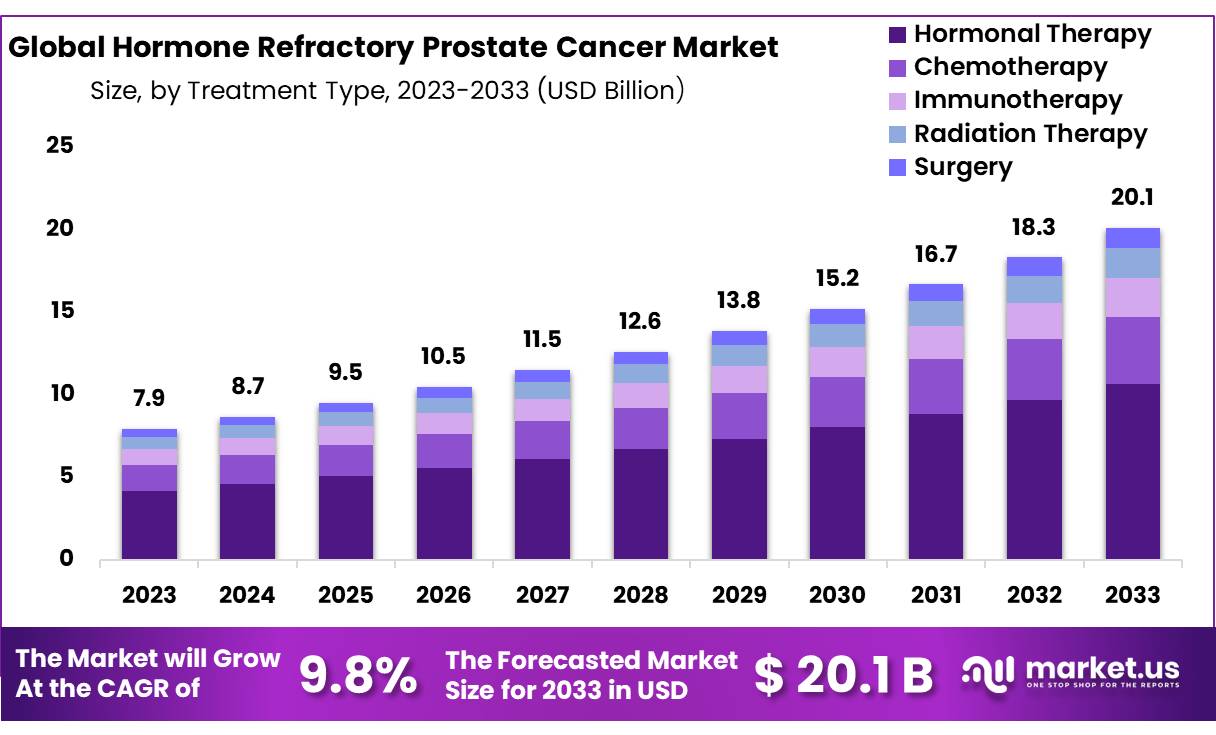Table of Contents
Overview
New York, NY – Oct 01, 2025 – The Global Hormone Refractory Prostate Cancer Market size is expected to be worth around USD 20.1 Billion by 2033 from USD 8.7 Billion in 2024, growing at a CAGR of 9.8% during the forecast period from 2025 to 2033.
Hormone Refractory Prostate Cancer (HRPC), also known as castration-resistant prostate cancer, represents a critical stage of the disease where tumor progression occurs despite androgen deprivation therapy. This advanced form of prostate cancer continues to present significant challenges in clinical management, necessitating the development of innovative therapeutic approaches.
The global burden of prostate cancer has been increasing, with HRPC accounting for a substantial proportion of late-stage diagnoses. The progression to hormone resistance marks a turning point in treatment, as conventional hormone-based regimens lose effectiveness. Current therapeutic strategies include chemotherapy, second-generation androgen receptor inhibitors, immunotherapies, and radiopharmaceuticals, which aim to prolong survival and improve quality of life for affected patients.
Research and clinical trials are increasingly focused on novel molecular targets and personalized medicine, underscoring the urgent need for more effective solutions. Rising awareness, expanding treatment options, and supportive healthcare policies are driving improvements in patient outcomes. However, unmet needs remain high, particularly in early detection of resistance and accessibility of advanced therapies in developing regions.
Industry stakeholders, including pharmaceutical innovators and research institutions, are investing significantly in drug discovery and advanced treatment modalities. With ongoing advancements, the HRPC landscape is expected to witness transformative changes, offering cautious optimism for patients and healthcare providers.

Key Takeaways
- Market Size: The Hormone Refractory Prostate Cancer (HRPC) market is projected to reach approximately USD 20.1 billion by 2033, rising from USD 7.9 billion in 2023.
- Market Growth: The market is anticipated to expand at a robust CAGR of 9.8% during the forecast period of 2024–2033.
- Treatment Type Analysis: Hormonal therapies remain the primary mode of treatment, accounting for 53% of the global market share in 2023.
- Application Analysis: HRPC treatment centers emerged as the leading application segment, representing 38% of the total market share in 2023.
- Regional Analysis: North America dominated the global HRPC market with a 38.1% share in 2023, supported by advanced healthcare infrastructure and access to innovative treatment options.
Regional Analysis
North America accounted for more than 38.1% of the global HRPC market share in 2023, supported by a highly advanced treatment landscape, strong presence of leading pharmaceutical players, and widespread access to innovative therapies.
The Asia-Pacific region is projected to record the fastest growth, with a compound annual growth rate of 9.76% during the forecast period. Major economies such as India and China are driving this expansion, supported by rising disposable incomes and growing demand for advanced healthcare services.
Take advantage of our unbeatable offer - buy now!

Increasing emphasis on quality of life, coupled with improvements in educational attainment, has enhanced awareness about cancer and available treatment options. These factors are expected to accelerate the adoption of HRPC therapies and strengthen the region’s overall market growth.
Frequently Asked Questions on Hormone Refractory Prostate Cancer
- What is Hormone Refractory Prostate Cancer (HRPC)?
Hormone Refractory Prostate Cancer (HRPC), also known as castration-resistant prostate cancer, is an advanced stage of prostate cancer where tumors continue to grow despite hormone therapy aimed at lowering testosterone or blocking its effects. - What are the symptoms of HRPC?
Symptoms of HRPC may include frequent urination, difficulty in urination, pain in the back or hips, weight loss, and fatigue. In advanced cases, it can spread to bones, leading to severe bone pain and fractures. - How is HRPC diagnosed?
Diagnosis of HRPC involves monitoring prostate-specific antigen (PSA) levels, imaging tests such as CT or bone scans, and evaluating tumor progression despite ongoing hormone therapy. Physicians combine clinical findings with test results to confirm resistance. - What treatment options are available for HRPC?
Treatment options for HRPC include chemotherapy, advanced hormonal therapies, immunotherapy, and radiopharmaceuticals. The choice of treatment depends on disease progression, patient health, and availability of therapies, with the aim of extending survival and improving quality of life. - Which treatment type dominates the HRPC market?
Hormonal therapies dominate the HRPC market, accounting for 53% of the global share in 2023. Despite emerging alternatives, hormonal therapy remains the cornerstone of management due to its accessibility, established clinical use, and widespread adoption among treatment providers. - Which application segment leads the HRPC market?
HRPC treatment centers are the leading application segment, commanding 38% of the total market share in 2023. Their prominence is attributed to specialized infrastructure, advanced diagnostic facilities, and tailored treatment solutions for patients at advanced cancer stages. - Which region has the largest HRPC market share?
North America held over 38.1% of the HRPC market share in 2023, driven by advanced healthcare infrastructure, strong research initiatives, and early adoption of innovative therapies, making the region the leading hub for HRPC treatment advancements. - Which region is expected to grow fastest in the HRPC market?
The Asia-Pacific region is projected to record the fastest growth with a 9.76% CAGR, supported by rising healthcare investments, expanding awareness about prostate cancer, and increasing demand for advanced treatment options in rapidly developing economies like India and China.
Conclusion
The global Hormone Refractory Prostate Cancer (HRPC) market is poised for significant expansion, driven by rising disease prevalence, growing demand for advanced therapies, and strong industry investment in innovative treatment approaches. While North America continues to lead due to advanced healthcare infrastructure, the Asia-Pacific region is expected to witness the fastest growth, supported by rising awareness, healthcare spending, and improved access to treatment.
Hormonal therapies currently dominate the market, though new modalities are rapidly emerging. Despite notable progress, challenges remain in early detection and accessibility, underscoring the importance of continued research and development to transform patient outcomes worldwide.
Discuss your needs with our analyst
Please share your requirements with more details so our analyst can check if they can solve your problem(s)



